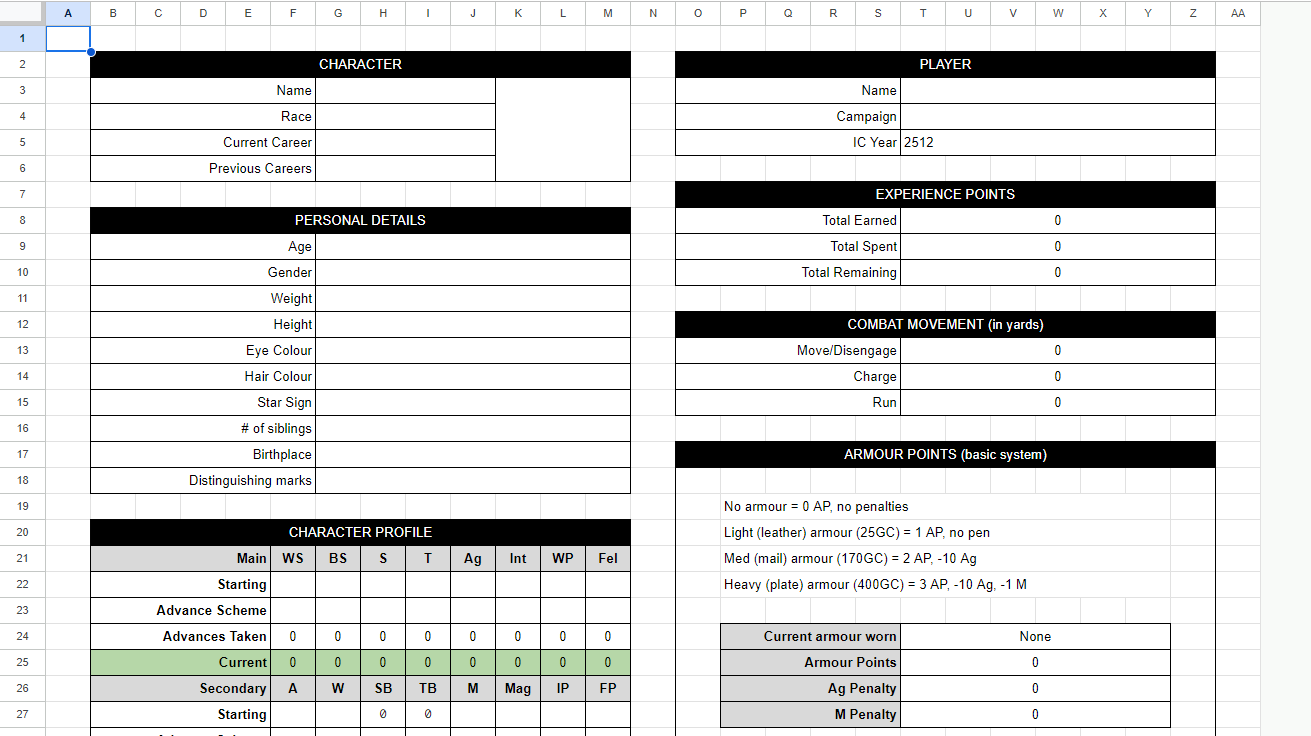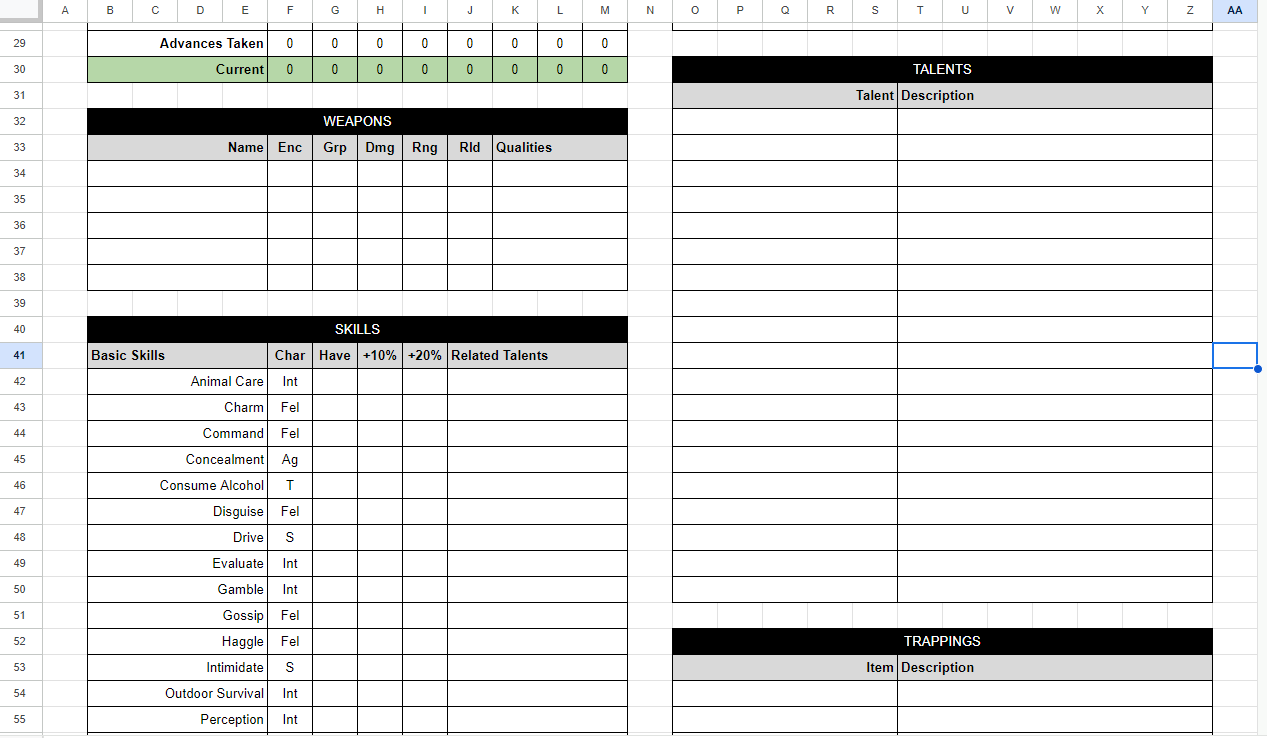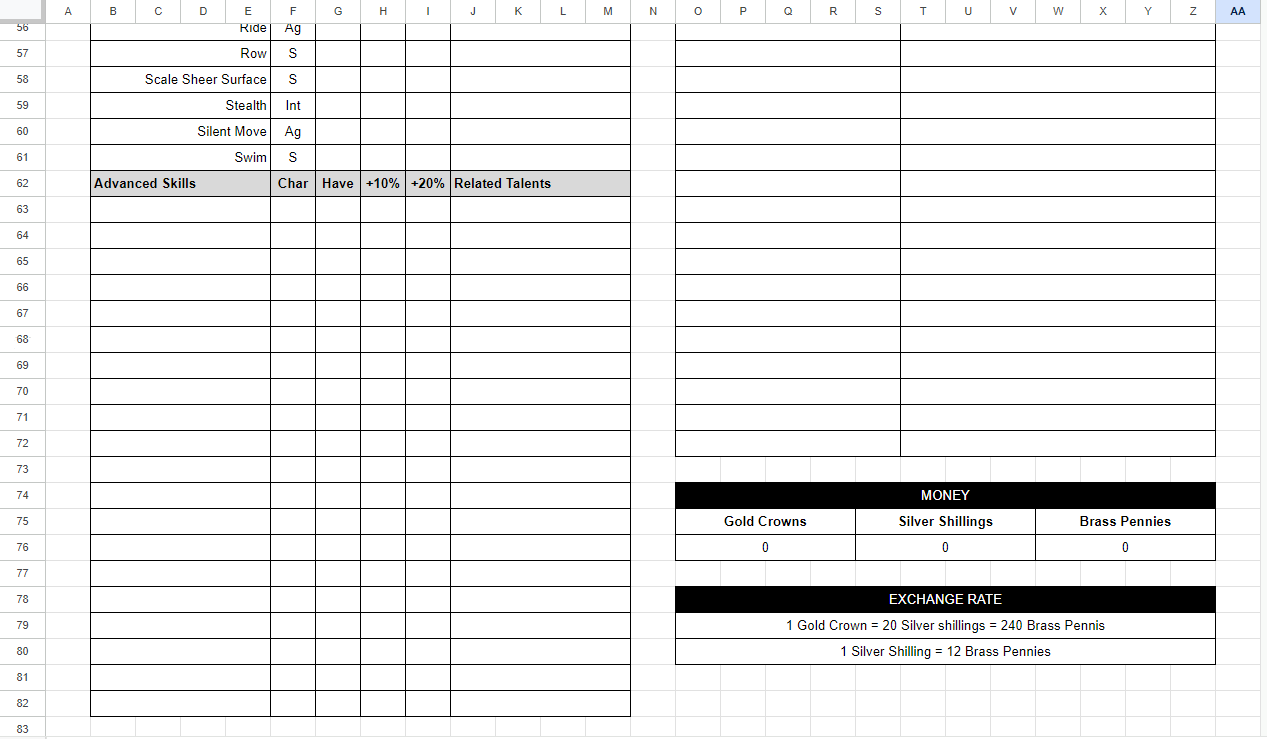As you may know I’m currently running my regular group through The Enemy Within, the classic campaign of insidious chaos cults for Warhammer Fantasy Roleplay (WFRP); I’m running it using the latest 4th Edition version from Cubicle 7 and am very much enjoying it. If you’d like to know more there is a page on this Substack with session write-ups:
https://reddicediaries.substack.com/p/the-enemy-within
When we first sat down to create characters for our Enemy Within campaign we did a session zero(ish) evening where we all got together, chatted and over the course of the evening created the characters for the game, which was good fun; however—as we went through it and in running the game since—I noticed that the character gen took a fair old amount of time, and there are a few bits of the rules that seem (to me) a little bloated compared to 2E.
I was talking about the campaign with some of my friends from LARP, a few of which are big Warhammer enthusiasts and they asked me whether I’d run them a campaign, of course I said yes; it occurred to me that this was an opportunity to test out how 2E and 4E differed in play. After checking my players were fine with using 2E for our upcoming campaign (which is going to be based in Ubersreik, using a number of the adventures for 4E but with re-worked stats for 2E) we arranged a time to create characters.
Differences During Character Gen
When we created the PCs for the 4E game we had the advantage of using a Google Sheet that I found online created by J Brannen where it does a lot of the stat calculation (putting in advance schemes, etc) for you, whereas for 2E, whilst we still had a Google Sheet, it was a lot more basic and I ending up re-working significant parts of it. However, the character generation for 2E still took a lot less time, we probably had it wrapped up in just over an hour, whereas the 4E character gen pretty much took all evening.
In-fact I think—during the 2E character gen—we spent more time joking about the random assortment of miscreants we were creating and talking about the party dynamic and inciting incident of the campaign (the PCs being accused of starting a riot and being sentenced to work in the Town Guard, lifted straight from the adventure book in the WFRP 4E starter set).
Character Sheets
Looking at a couple of the character sheets from both groups, there appears to be a lot more “stuff” on the 4E character sheet. I’m sure some of this is partly because J Brannen’s character sheet is so comprehensive and includes a lot of quality-of-life style improvements such as XP logs, places to note down NPC details, etc whereas the re-worked character sheet we used for the 2E session zero is extremely basic and I ended up re-building large portions of it.
Below are three screenshots showing the sheet for 2E:
I don’t think that the character sheet differences 100% explain the time differences though, keep in mind that my 4E group is my regular group of players, we’re all used to make characters, playing in online games and stuff like that, whereas my 2E group are a bit less familiar with this and have minimal to no experience of WFRP, so I would’ve expected the 2E group to require a bit more coaching in this regard, but that didn’t seem to be the case.
Simpler rules subsystems
In the interests of transparency I should put out that—prior to starting the 2E game—I had decided to use the simplified armour system from that game, where essentially you just have one set of armour points that deducts from all incoming damage, rather than having separate armour values for various locations (which is also the system that 4E uses by default), again this was done for the sake of simplicity. I also made the decision to use the “sudden death” critical hit rules, which effectively mean that—whenever you take critical damage—you’re either dead or fine rather than having to track a variety of different long and short-term injuries.
In 4E the only system I really use in a simplified form was for determining success levels when making dice rolls, the standard method for determining success levels in 4E involves subtracting the 10s number of the 1d100 roll from the 10s number of the characteristic or skill being tested (including any modifiers), whereas the Fast SL system simply involves taking the 10s number of the 1d100 dice roll and (if successfully) that is your number of success levels.
The Character Gen Process
Second Edition
The process for 2E is as follows:
Choose your race.
Roll characteristics.
Record racial features.
Roll for personal details.
Roll and record the details for a starting career.
Take one free advance.
Fourth Edition
The character genning process for 4E is:
Choose or roll your species.
Choose or roll class and career.
Roll attributes.
Determine skills & talents.
Determine trappings.
Add any details.
Add party ambitions and the like.
Determine your personal details.
Spend any starting XP on advancements.
The character creation process for 2E felt a lot more “old-school”, you pretty much just choose Human, Elf, Dwarf or Halfling and then you roll everything else, pick a single advance from your starting career and boom, you’re off to the races, whereas 4E offers numerous choices, at several points the players can either accept a random roll and get some bonus XP or they have various gradients of choice which result in getting less to no bonus XP. This certainly took up a lot more time during the 4E character generation, but I think potentially it gives the players more options when running RAW for the players to get the adventurer that they envision.
I think that largely this is a matter of preference as to which you prefer, the players for my 2E group were all happy to just roll with whatever character they got so it took virtually no time at all to create their characters, whereas I think my 4E group preferred to have a bit more of a say in what their characters ended up like. There’s no real right or wrong when it comes to this, but the second option does take considerably more time.
Verdict
Overall I’m enjoying running 4E, but to me it does seem a bit unnecessarily complex or bloating in certain areas, and I’m sure there are rules that I’m not using to their full, just to streamline the sessions a bit, but—from my memories of playing 2E and what I’ve seen in our 4E game—it does seem that 4E characters are a bit more heroic and competent straight out of the gate. The Enemy Within sees you fighting mutants and such-like pretty early in the campaign, which—with a bit of planning—our PCs were able to pretty easily overcome, whereas I remember fighting against street toughs as a starting character in 2E and having a pretty rough time of it.
I’m looking forward to our 2E game starting in a couple of weeks and seeing how the two systems stack up against each other, and also how challenging it is going to be to convert some of the Ubersreik 4E stuff to be 2E compatible.




